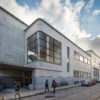Erasing the traces of time or getting closer to perfection? Many people assume that plastic surgery is just a “cosmetic” surgery. However, the reconstruction of structures and proportions often has predominantly functional objectives. This becomes clear in a discussion with Jan Plock, specialist in plastic and reconstructive surgery.
Professor Plock, to what extent would you say your work is associated with “restoration”?
Jan Plock: “Restoration” is actually a very apt word in this regard. It comes from the Latin word “restaurare”, meaning to repair and reconstruct. Hence restoration is a fairly good word to describe the work of a plastic surgeon. Plastic surgery is all about repairing and restoring.
Jan Plock: “Restoration” is actually a very apt word in this regard. It comes from the Latin word “restaurare”, meaning to repair and reconstruct. Hence restoration is a fairly good word to describe the work of a plastic surgeon. Plastic surgery is all about repairing and restoring.
What exactly does a plastic surgeon restore
Plastic surgery is actually a very broad field. It is usually subcategorised as “cosmetic” and “reconstructive” surgery. Reconstructive surgery is concerned with the restoration of structures or functions that the body has lost, for example following an accident, burns or the removal of tumours, as well as congenital defects. This includes nerve and muscle defects, as well as the body’s shape and appearance. Cosmetic surgery is performed to correct so-called formal imperfections, and these imperfections are all perceived differently by each individual. But in my experience, the two areas are not so clear cut.
Does this mean that it is not possible to separate aesthetics and function when it comes to the human body?
It’s certainly very difficult – form and function are in very close quarters here. In English we say “form follows function”. For example, in my everyday work I treat people with very serious burns. For these patients, the primary concern is generally to ensure the vital functions of the skin and soft tissue. Once the body’s surface – i.e. the skin – has healed, the next step might be to improve the appearance of scars.
So it’s then about looks?
Definitely, but on the basis of the best-possible functionality. Scarred skin, for example, can severely restrict the movement of a hand, leg or face. The primary aim of surgical intervention, beyond improving function, is for the patient to regain their self-confidence. In the case of scarring on visible parts of the body such as the hands and face, this aspect also clearly extends into the realm of aesthetics. Ultimately, the aim is to also restore the appearance of a person disfigured by fire, illness or an accident as best as possible.
So attractiveness inevitably plays a role?
The attractiveness of a person is about much more than just looks. For that matter, we perceive symmetry as beautiful, for example. Symmetry “functions” very well in many areas and therefore appears healthy with regard to the body. This is why it appeals to us so much. Fundamentally, however, appearance has a clear social function. The way in which each person interprets it comes down to the individual. Not everything is practical and recommended for everyone – even if it is feasible.
Speaking of feasibility, medicine and technology are making rapid progress all the time. How do doctors keep up with these developments and the demands for highly specialised services?
A willingness to cooperate plays a huge role here. Increasing specialisation can only bear fruit if the separate knowledge of each individual is pooled together again. This includes research work at universities. As far as plastic surgery is concerned, this research work is happening in the area of regenerative medicine, as well as in skin replacement research and the treatment of wounds. This also depends on the implementation of new technology, such as robots, and on ensuring the availability of scientific data. In the end, however, everything needs to be economically viable.
Where is plastic surgery heading?
We are noticing increased specialisation. On the one hand, there are plastic surgeons who focus on repairing breasts following breast cancer treatment, for example. On the other hand, personalised treatment concepts for the patient, for example due to individual genetic or rare health conditions, are playing an ever increasing role.
Prof. Dr. med. Jan Plock heads the centre for burn victims at the University Hospital in Zurich (USZ). He is a specialist in plastic surgery and hand surgery. He completed his education in Switzerland, Germany and the USA. He is also a researcher in the area of reconstructive surgery and is part of an international research network. He has been an assistant professor at the University of Zurich since 2017.
Image source: Conzept-B, Zürich

